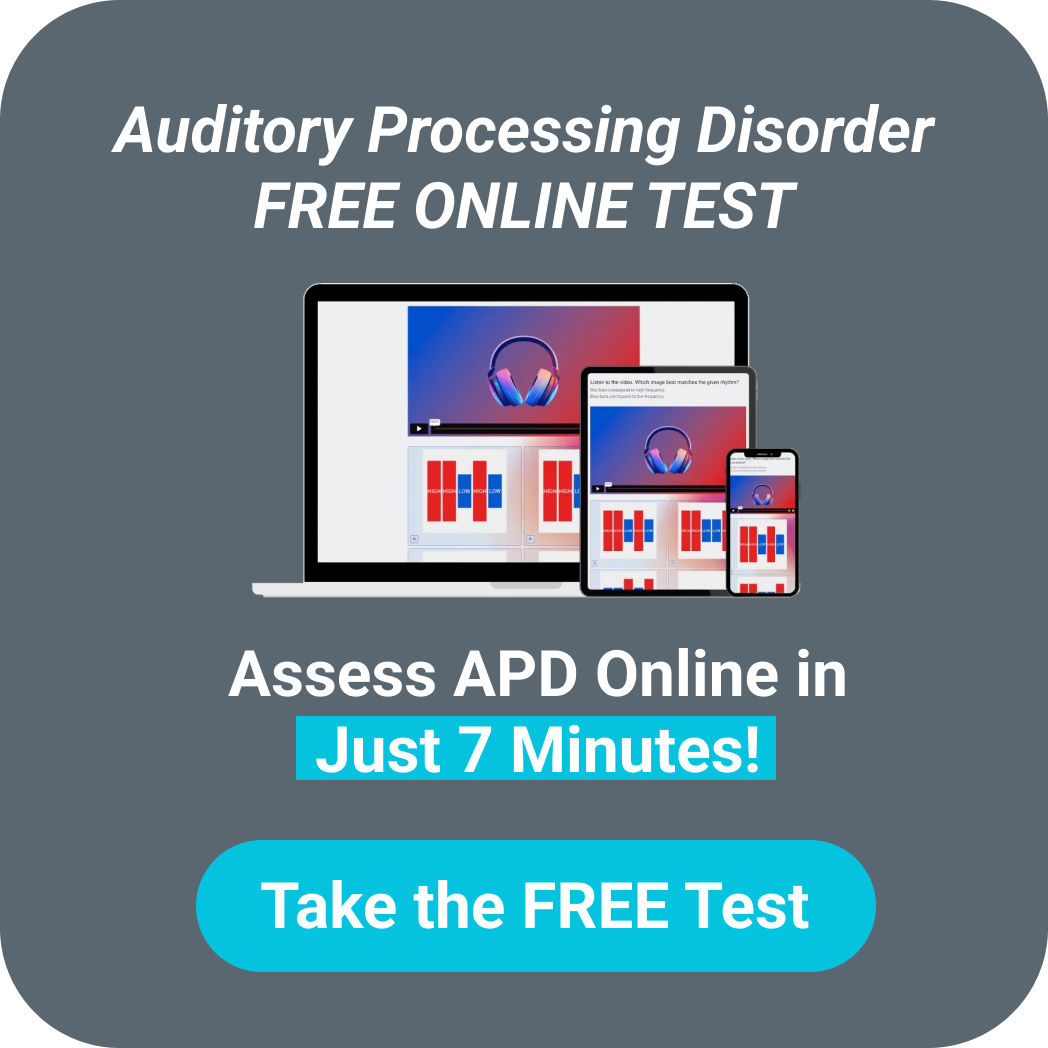A Parent’s Guide to Auditory Processing Disorder Testing in Children
 Rachel Ann Melegrito
Rachel Ann Melegrito Occupational Therapist
October 17, 2024
Introduction
Talking to someone over a choppy line is frustrating; some words are clear, while others are garbled—this is how kids with central auditory processing disorder (CAPD) or auditory processing disorder (APD) describe what they hear.
CAPD affects the brain’s ability to process sounds. Children with APD have normal hearing, but the breakdown happens in the brain’s sound processing area, the central auditory nervous system (CANS). Because auditory processing affects speech, language, and communication, APD can greatly impact a child’s daily life, making accurate diagnosis and treatment necessary.
Experts use an array of auditory processing disorder tests that assess particular auditory processing skills to evaluate the integrity of the CANS and diagnose APD. This article explores common symptoms of APD and discusses some of the auditory processing disorder tests experts use for diagnosis.
Key Take-Away Messages
| How do you test for Auditory Processing Disorder (APD) in Children? |
Auditory processing disorder tests typically involve behavioral and electrophysiological tests. Behavioral tests involve presenting sounds to one or both ears to assess the individual’s perception of sounds [1]. Meanwhile, electrophysiological tests use small surface electrodes on the ears and forehead to measure the inner ear and auditory nerve’s response to sounds [2]. |
Common APD Symptoms in Children
Children with APD often struggle to hear in noisy places and take longer to process sounds. Here are some common symptoms and behaviors seen in those with CAPD [3]:
- Struggles with understanding speech in noisy or echoey places
- Finds it difficult to locate the source of sounds
- Gives inconsistent or incorrect answers to questions
- Has trouble following fast speakers
- Struggles to follow directions, especially complex ones
- Frequently asks people to repeat themselves
- Can’t detect changes in tone for jokes and sarcasm
- Finds it hard to stay focused
- Gets easily distracted
- Struggles with singing and musical activities
It’s important to understand that these symptoms overlap with many behaviors and characteristics seen in other conditions. A formal diagnosis can help identify if the child has CAPD, another condition, or both. For instance, auditory processing disorder and ADHD may co-exist, with 60% of individuals with ADHD combined type also having CAPD [4].
There are no studies on the prevalence of co-occurring auditory processing disorder and autism in children. However, a 2016 study mentioned that 50 to 70% of those with autism spectrum disorder (ASD) demonstrate abnormal responses to environmental sounds [5].
Our Free Auditory Processing Disorder Self-Test for Children
The self-test below is adapted from the signs and symptoms of CAPD outlined by the American Speech-Language Hearing Association.
Disclaimer: This online auditory processing disorder test is not a diagnostic test but helps determine if your child may need further screening and testing for CAPD.
Do you think your child has auditory processing disorder? Take this test to see if their behaviors raise concerns. Keep in mind that APD symptoms can overlap with those of other neurodevelopmental and learning disorders, like ADHD and autism.
If your child score is below 15, they may have auditory processing issues and should be assessed by an audiologist or speech-language pathologist (SLP).
Auditory Figure-Ground Test
An auditory figure-ground discrimination test is the ability to pick out essential sounds while tuning out background noise. Testing involves listening to a recording of one-syllable words with background chatter, with the words being 8 decibels (dB) louder than the noise. Here’s an example for you to get an idea of what the 8 dB difference is: a soft whisper is about 32 dB while a quiet conversation inside a library is around 40 dB–the difference between the two is 8 dB.
The individual should repeat the words in the presence of the background noise.
A child with this auditory deficit may struggle to follow conversations due to an inability to filter out background noise. They may also find it hard to focus on verbal directions or lessons in class.
Auditory Memory Test
An auditory memory test is the ability to recall what was heard after a period of time. It has two types:
- short-term, or immediately recalling the details of what they just heard,
- long-term, or the ability to remember something heard some time ago.
This is typically assessed by asking the individual to recall a list of digits or unrelated words immediately and after a few minutes of delay.
Children with poor auditory memory may find it hard to recall people’s names, follow multi-step directions, recall song lyrics and stories, or memorize phone numbers.
Additional Tests Administered
Below are other common auditory processing skills that audiologists may assess:
- Auditory discrimination: ability to notice and distinguish differences between sounds and words
- Auditory sequencing: ability to recall a sequence of words in the exact order they were presented.
- Auditory attention: ability to focus attention on sound for a certain length of time.
- Auditory closure: ability to recognize and fill in sounds when some information is missing or distorted to recognize the entire message.
- Binaural integration: ability to process different information presented in both ears simultaneously.
- Binaural separation: ability to process a message presented in one ear while ignoring the sound simultaneously presented to the other ear.
The type of test an audiologist gives depends on the child’s age, history, and results from language, cognitive, and hearing tests, as well as their developmental status and abilities.
The evaluation may take several sessions, depending on the child’s motivation, attention, and energy. Audiologists often run multiple tests to assess different processes and ensure the child is on their usual medication to avoid misleading or confusing results.
Understanding Test Results
The audiologist will interpret results based on expected results based on age (normative data) or the child’s baseline results. They may also compare the results of different tests to look for patterns and inconsistencies.
According to ASHA, a positive diagnosis typically involves performance deficits in one or both ears at least two standard deviations below the mean on two or more tests [1]. If poor performance is observed on only one test, experts may withhold a diagnosis unless the performance is at least three standard deviations below the mean or there are significant functional difficulties.
The audiologist will create a plan based on the evaluation results and suggest auditory processing disorder therapies to address the difficulties and provide recommendations to improve the child’s daily communication.
Common Intervention Strategies
Since every child has unique needs, a multi-disciplinary team will craft an individualized plan to help the child communicate more effectively. Intervention typically involves a combination of the following treatment approaches:
- Auditory skills training: addresses specific auditory processing difficulties
- Compensatory strategies: involve using and strengthening the child’s other abilities to enhance their communication
- Environmental modifications: improves child’s access to sounds either by improving the listening environment or the sound they need to hear
Since a child’s listening and learning demands change over time, they need ongoing monitoring and support to adjust the treatment approach. The same is true even for auditory processing disorder in adults.
Summary
Auditory processing disorder can significantly impact your child’s life. Accurate and timely diagnosis can make a world of difference for your child, helping them thrive and better cope with their challenges.
FAQs
How do you diagnose Auditory Processing Disorder in Children?
Diagnosing APD in children involves running a series of tests to determine the integrity of the central auditory nervous system. This typically consists of the use of different behavioral and electrophysiological tests.
Are you born with Auditory Processing Disorder?
The cause of APD is often unknown. However, you may be born with it, as it can run in families or result from prematurity or low birth weight.
References
- American Speech-Language-Hearing Association. (n.d.). Central auditory processing disorder. Retrieved June 7, 2024, from https://www.asha.org/practice-portal/clinical-topics/central-auditory-processing-disorder/
- Quality Hearing Aid Center. (n.d.). Electrophysiological evaluations. Retrieved June 7, 2024, from https://hearingaidsforyou.com/hearing-care-services/electrophysiological-evaluations/
- American Academy of Audiology. (2010). Diagnosis, Treatment and Management of Children and Adults with Central Auditory Processing Disorder. https://www.audiology.org/wp-content/uploads/2021/05/CAPD-Guidelines-8-2010-1.pdf_539952af956c79.73897613-1.pdf
- Hegazi, M. A., Khalil, G. M., Mohamed, S. M., & Khodeir, M. S. (2024). Exploring the relation between the central auditory processing functions and language development among Arabic-speaking children with attention deficit hyperactivity disorder. The Egyptian Journal of Otolaryngology/the Egyptian Journal of Otolaryngology, 40(1). https://doi.org/10.1186/s43163-023-00557-2
- Williams, Z. J., He, J. L., Cascio, C. J., & Woynaroski, T. G. (2021). A review of decreased sound tolerance in autism: Definitions, phenomenology, and potential mechanisms. Neuroscience and biobehavioral reviews, 121, 1–17. https://doi.org/10.1016/j.neubiorev.2020.11.030




